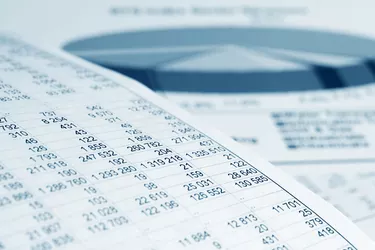
The book value of debt is one of the metrics by which a company's worth and future viability are evaluated. A company's book value of debt on its balance sheet represents all outstanding debt currently acquiring interest.
While market value is based on the value of traded shares and the number of outstanding shares, book value is the real-world dollar amount the company would be worth if all assets were liquidated and all outstanding debts were settled. By evaluating the ability of a business to cover liabilities with some amount of surplus, investors and lending institutions can determine how capable the company is of supporting its current and future debt load.
Video of the Day
Video of the Day
Book Value of Debt on Balance Sheets
Balance sheets are a kind of snapshot of a company's financial state at any given moment in time. As the American Accounting Association puts it, the liabilities listed in the book value of debt do not include the interest rates of loans, the length of loans or any repayment schedules. An investor or potential buyer for a company might review a balance sheet before making a decision.
Similarly, assets that are included don't list projected gains from interest, only their current value if liquidated. As such, some liabilities are not included in calculating the book value of debt, such as accounts payable or accrued liabilities. These liabilities are considered short-term and already accounted for in the current period's spending, as opposed to interest-bearing loans. Therefore, these short-term debts are not counted amongst the liabilities, which would need to be paid off upon liquidation.
The takeaway from this is that although two companies may have the same book value of debt, they can have very different risk profiles, resulting in a different market value of the company compared to its book value. Investors or businesses looking to acquire a company must understand this nuance of risk profiles before they make any financial choices. Seeing a holistic picture of the company is critical in order to understand its complete risk profile and the book value of debt on balance sheets.
Market Value vs. Book Value
While book value, as described above, provides a basic understanding of a company's solvency, market value is explained by the writers at Simple-Accounting.org as the current price of each share multiplied by the number of outstanding shares. Outstanding shares can be understood as the number of shares issued by the company and owned by investors. This is as opposed to shares that have not been sold or are company-owned.
A company's share price can be influenced by its book value, but investors' perception of its performance more often shapes it. Even if a company is currently insolvent, if the returns on investments made using the loans it holds presently are expected to be greater than the debts incurred to make those investments, the share price may increase compared to a point when its book value was higher. This is very common and occurs as a result of business decisions, public relations changes and other public-facing company choices.
Formulas and Calculations
Writers from New York University's Stern College of Business offer a basic formula for calculating a company's market value debt from its book value debt. While it's possible to evaluate each loan's expected cost and then sum them, NYU's suggested solution is to treat all liabilities as a single coupon bond.
They suggest that you take the book value of debt, average the interest expenses with a face-value weighted average of their maturities and evaluate how this will impact the company's market value over the course of the coupon. A careful analysis can ensure you make the right financial choice.
Consider also: Book Value vs. Market Value
- Accounting Tools: Book Value of Debt Definition
- Simple Accounting: Book Value Vs. Market Value: An Overview
- American Accounting Association: Response to Proposed Accounting Standards Update: Accounting for Financial Instruments and Revisions to the Accounting for Derivative Instruments and Hedging Activities
- New York University Stern College of Business: Estimating Market Value of Debt